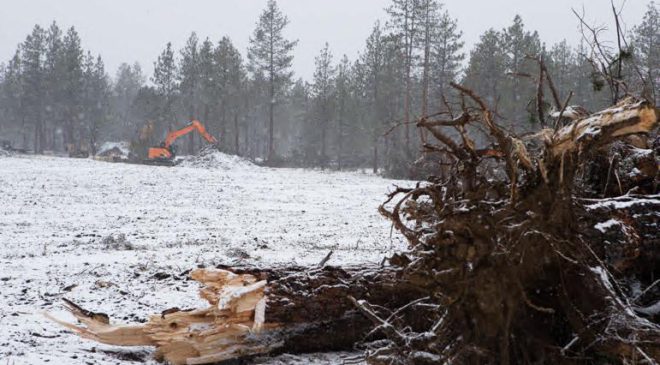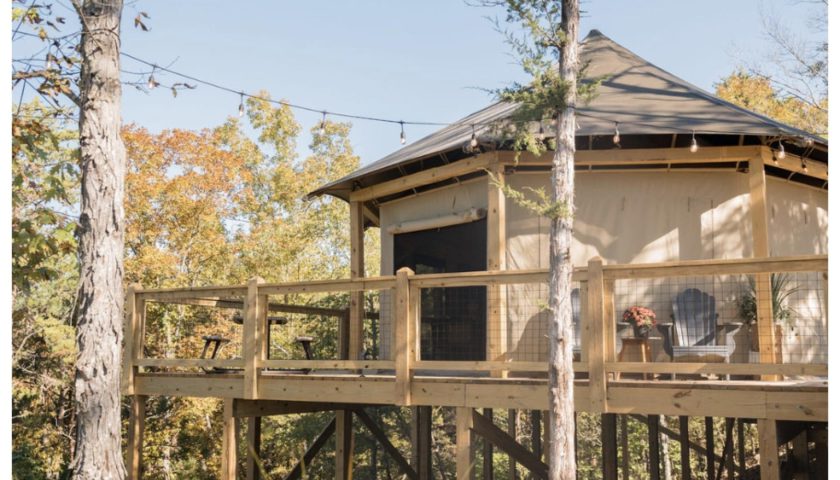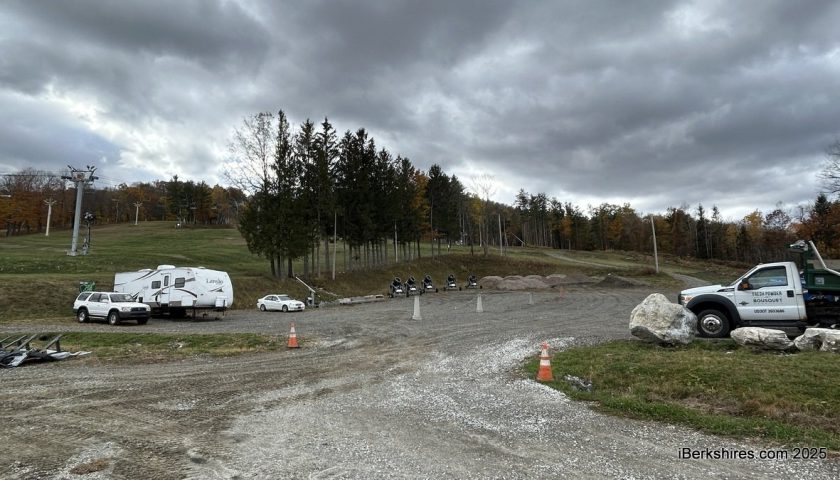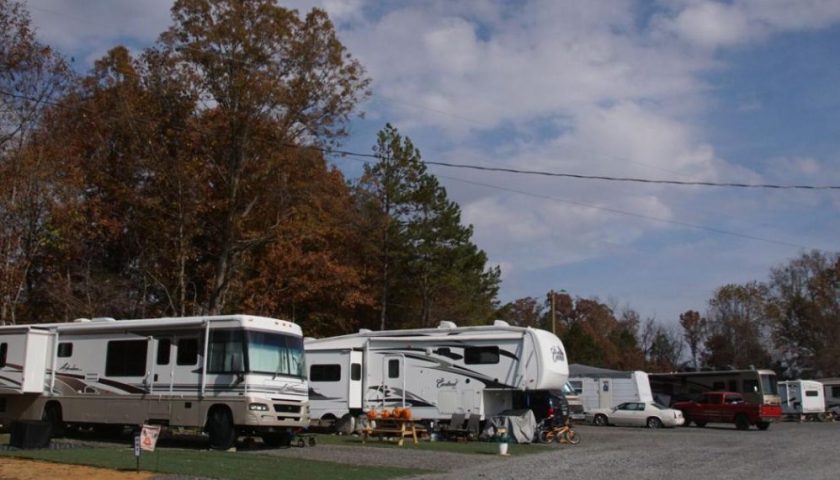A plan to develop an RV park on Bend’s forested southern fringe moved forward last week when the developer had most of a 13-acre lot cleared of ponderosa pines and juniper trees.
Bend-based Kine & Kine Properties owns the land and intends to build the 176-space RV park and open it before the end of the year.
In addition to the 13-acre RV park, a variety of other features are also planned on the 29.3 acre property, including mini storage, RV storage and seven acres of residential units.
At a time when the planet is faced with a global climate crisis, Bend is among a growing list of cities that are losing their carbon sinks like forestland to commercial projects that could otherwise be saved to offset fossil fuel emissions. The average pine tree absorbs approximately 16 pounds of CO2 per year. The loss of forest in urban areas also scales back habitat for deer, skunk, raccoon and other woodland creatures.
These sites are difficult to develop. You have to grade them. You have to install utilities. You have to install all of the structures including the parking lots they have proposed and most of the time that results in the trees coming out.”
At the Murphy Road RV park project, some trees were left standing around the perimeter of the property but selectively leaving larger trees in the central area of the property was not part of the development plan. After days of cutting, with the sound of saws filling the air, a large log pile now occupies one corner of the property. Stumps of trees uprooted from the ground are stacked high in a nearby jumble of shredded vegetation.
Property owner Larry Kine said he wanted to keep more mature trees to create a woodsy look and feel for the RV park but blamed the city for not developing the sewage system properly in the area, alleged mistakes that he says forced him to clear the area and conduct earth-filling work.
“We were hoping to save a lot more trees, but the city did not put an existing sewer line deep enough,” said Kine. “The property slopes off towards Murphy. We have to do some filling in there for it to be able to meet gravity sewer to get back over to the city’s sewer main that goes through the middle of the property.”
“Not only are we spending a bunch more money to cut out the trees, plant trees, put in a bigger sewer line and do a fill because the city did poor planning, it also diminishes from the RV park because we will have new trees in there instead of nice mature trees that were there and we tried to work around,” he added.
Kine said he does not have a timeline for what comes next after the forest was cleared and has only received a grading permit from the city. “Other permits still could take forever as the city is slower than molasses in the Arctic,” said Kine.
Colin Stephens, Bend’s community and economic development director, disputes Kine’s reason for cutting so many trees. He said Kine had proposed to cut the trees and that Kine had to demonstrate that their removal is needed in order to perform the type of development that he proposed.
We actively try to promote housing in our commercial districts. We have seen interest in doing that, but this developer didn’t want to do that. They have their own pro forma that they believe is the best for them and that is their prerogative.”
“He proposes an (RV park), which requires a lot of paving and other site improvements and grading to make it work. So for him to say that it’s because the city, through some public utility project, forced him to cut trees on his own private property, that doesn’t add up,” said Stephens.
Stephens said the 12-inch, east-west sewer line in question was installed in the 1990s and is 18 feet deep.
“That is a relatively deep sewer line to connect to,” said Stephens. “In any event, that isn’t one of the reasons the developer used when justifying the tree felling to the hearings officer, nor was it a reason used by the hearings officer in the decision. So it is not relevant in the scope of the land use approval.”
Stephens said the city has legal obligations to allow the cutting of the trees if the hearing officer determines that the code has been met.
“These sites are difficult to develop. You have to grade them. You have to install utilities. You have to install all of the structures including the parking lots they have proposed and most of the time that results in the trees coming out,” said Stephens.
Stephens said the city does encourage the development of housing projects in order to address Bend’s housing shortage and soaring real estate prices, but he said ultimately it’s up to developers to decide how they want to spend their money.

“We actively try to promote housing in our commercial districts. We have seen interest in doing that, but this developer didn’t want to do that. They have their own pro forma that they believe is the best for them and that is their prerogative,” he said.
“Protecting the environment and developing undeveloped land within the city in order to avoid sprawl are important goals that the city needs to balance,” said Bend Mayor-elect Melanie Kebler, “but the City Council never looked at the Murphy Road RV park project.”
Although “that decision was never appealed to council and thus we never weighed in, I continue to recognize the need for a wider community conversation around both vehicle-centric uses and tree preservation within our city,” said Kebler. “Council has planned a deeper look at how we could update our code around tree preservation for the beginning of next year.”
Ariel Méndez, elected to the City Council in November, said, “Nobody wants to see trees removed unnecessarily,” and he looks forward to looking at policies that uphold the public interest without being overly prescriptive about what developers can do. He said the experience on Murphy Road will inform any decisions that Bend’s City Council makes next year on a tree preservation code.
Disputes over the cutting of trees also erupted in Bend in May when a number of trees were felled in the Phil’s Trail area as part of a thinning operation to reduce the likelihood of wildfire.
While it was not a clear-cut similar to the one on Murphy Road, the cutting of those trees did create uproar in Bend’s environmental community and prompted the Bend City Council to send a letter of concern to the U.S. Forest Service, urging it to stop cutting large trees.
“Sadly, there aren’t a lot of actual safeguards for forests at the local or regional level,” said Erik Fernandez, wilderness program manager for Oregon Wild. “On public lands like the Deschutes National Forest, there are some tools, but even those are under constant threat from Congress and logging interests.”

“Trees and forests on private lands that provide multiple benefits — from wildlife habitat and carbon storage to just being nice places to have in your neighborhood — are vulnerable to logging and development with little recourse available to the public,” Fernandez added.
Some residents in southwest Bend did express concern over the clear-cut. Judy Clinton, the land use chair of the Southwest Bend Neighborhood Association, called the cutting of mature trees on Murphy Road “horrific,” suggesting that it may have been possible for the developer to keep the large trees.
“It takes more design time and money, but it makes for a better city,” she said.
Clinton ticked off some of the benefits of trees in the urban setting beyond their aesthetics. They mitigate Bend’s heat island effect, provide a sanctuary for migrating and local birds and sequester carbon.
“It is time for each city to take some responsibility for their contribution to a warming climate,” she said.
“Bend has missed that opportunity and trashed the Murphy Crossing Refinement Plan by misreading of its code.”
Don Horton, executive director of the Bend Park & Recreation District, said that a park is planned for the area to serve nearby neighborhoods, including the Windcamper Affordable Housing complex to the south and a mobile home park to the west.
But Kine said it’s not clear if a park can be built on the site. Kine said he was asked to donate a portion of his land to build the park.
“So now everyone is asking us to give it to (the) parks district and we are not a charitable organization where we give things away,” said Kine. “We are a business. We are not giving it, so (the district) is going to have to figure out another way, or we will have to put a DMV or something else on it.”
Horton did not address this Murphy Road clear-cut specifically but did lament that Bend is rapidly losing its trees.
“The loss of ponderosas and other tree species across Bend is unfortunate,” said Horton. “A strong tree ordinance needs to be put into place soon in order to meet Climate Action Plan goals and to preserve one of the essential components of building livable communities in Central Oregon.”



